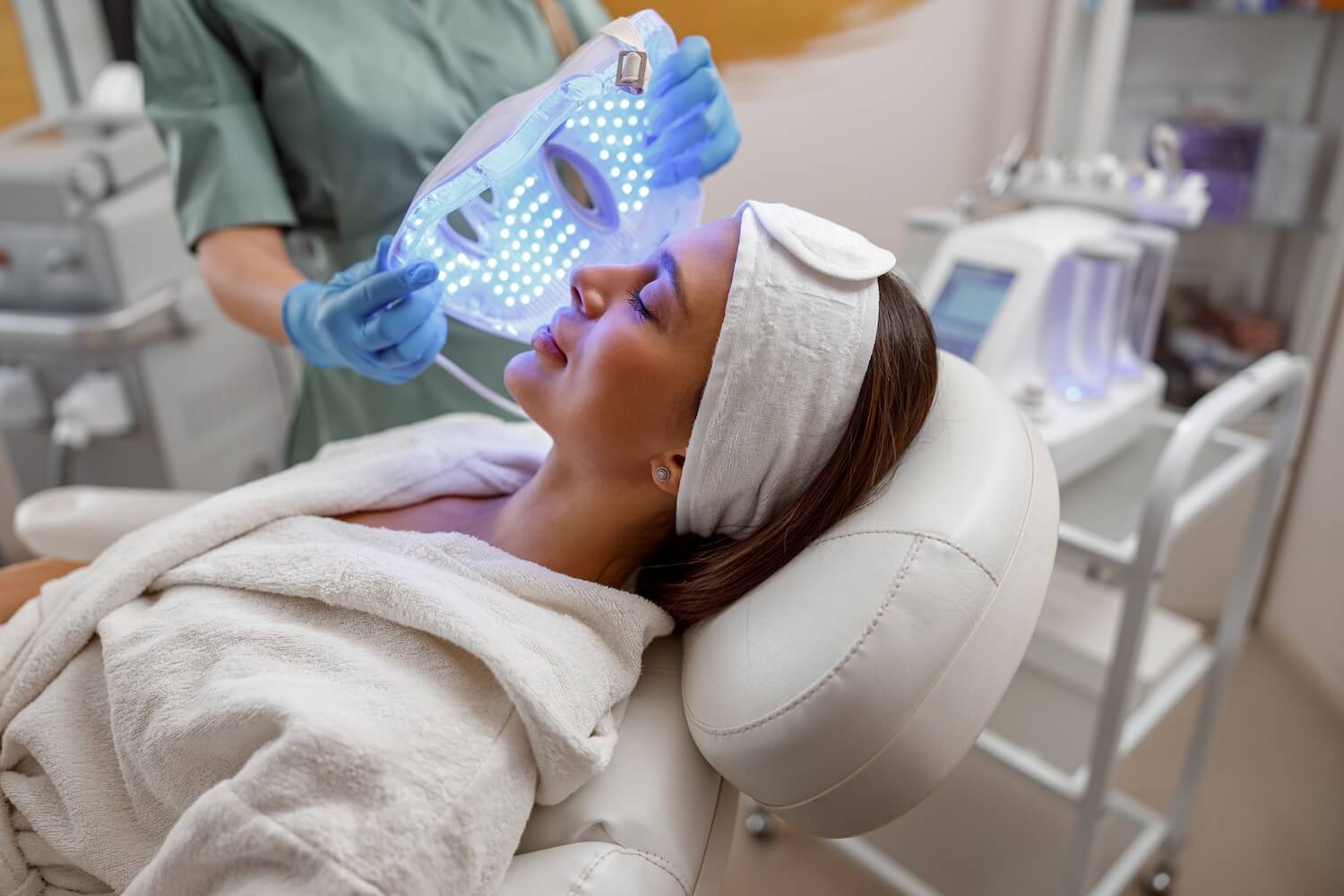In the evolving world of skincare, LED light therapy has emerged as a cutting-edge treatment that addresses a wide range of skin concerns—from persistent acne to signs of aging. As a non-invasive, painless, and effective option, LED light therapy has quickly become a staple in professional dermatology and aesthetic practices. With targeted use of specific light wavelengths, this therapy offers a safe way to rejuvenate and heal skin without the recovery time or risks associated with more invasive treatments. This article delves into the science behind LED light therapy, its diverse applications for skin concerns, the benefits of receiving professional treatments, and why it’s crucial to work with licensed providers to maximize results.
Understanding LED Light Therapy: The Science Behind the Light
LED light therapy involves the application of specific wavelengths of light energy to the skin, which stimulates various cellular processes to promote skin health. Unlike lasers or intense pulsed light (IPL), LED therapy uses low-intensity light, making it safe for all skin types and suitable for people with sensitive skin. Each wavelength corresponds to a color—typically red, blue, or near-infrared—each of which targets different layers of the skin to treat specific concerns.
The Mechanisms of LED Light Therapy
LED light therapy operates on a process called photobiomodulation, which uses light energy to initiate beneficial reactions within skin cells:
- Red Light (620-750 nm): Red light penetrates deeply, stimulating the production of collagen and elastin. It also enhances cellular metabolism and circulation, which can result in smoother, more youthful-looking skin. Because collagen and elastin are crucial proteins for skin structure, red light therapy is widely used in anti-aging treatments to reduce wrinkles, fine lines, and sagging.
- Blue Light (405-420 nm): Blue light is mainly used to target Propionibacterium acnes bacteria that cause acne. By neutralizing these bacteria and reducing inflammation, blue light helps treat active acne and prevent new breakouts. It also calms the skin, minimizing redness and inflammation associated with acne lesions.
- Near-Infrared Light (800-850 nm): Near-infrared light penetrates deeper than other wavelengths, reaching the dermis and even underlying tissues. This makes it highly effective for reducing inflammation, alleviating pain, and enhancing the body’s natural healing processes. Near-infrared light therapy is often used in professional settings for clients who require deeper tissue rejuvenation or who are dealing with chronic skin conditions that cause inflammation.
Why Professional LED Light Therapy Is Superior to DIY Options
While at-home LED devices are widely available, professional LED light therapy offers substantial advantages in terms of efficacy, safety, and customization. Here are several reasons why it’s best to seek out professional treatments:
1. Higher Intensity and Better Results
Professional LED devices are significantly more powerful than DIY devices. The higher intensity allows the light to penetrate deeper into the skin, resulting in faster and more effective treatments. While home devices may take months to yield visible results, professional treatments can deliver noticeable improvements within weeks.
2. Tailored Treatments for Your Unique Skin Type
Professional skincare providers are trained to assess individual skin types, conditions, and goals. They will select the most appropriate wavelength, duration, and frequency of treatment based on your specific skin needs, ensuring maximum benefit and minimal risk. This personalized approach cannot be achieved with a DIY device, which generally uses one wavelength and lacks adjustability.
3. Controlled and Safe Environment
Undergoing LED therapy in a professional setting ensures that all equipment is properly maintained, calibrated, and used in a safe, sterile environment. Additionally, professionals are trained to recognize skin sensitivities and reactions, minimizing the risk of adverse effects.
4. Comprehensive Skin Care
Professionals can combine LED light therapy with complementary treatments, such as microdermabrasion, chemical peels, or hydrating facials, to enhance results. This multimodal approach offers a more comprehensive solution to skin concerns, addressing different aspects of skin health and appearance in one session.
Addressing Specific Skin Concerns with LED Light Therapy
1. Acne and Breakouts
Acne is one of the most common skin conditions, affecting millions worldwide. Blue light therapy has been clinically proven to target the bacteria responsible for acne, reducing inflammation, and preventing future breakouts. With consistent use, blue light can help clear existing acne lesions and inhibit new ones, all without the harsh side effects of traditional acne treatments.
How It Works in a Professional Setting
In a clinical setting, the professional will cleanse your skin before applying blue light to the areas affected by acne. They may also use specialized serums that complement blue light therapy, improving results and soothing the skin. Because blue light is non-invasive and gentle, most clients can return to their daily routines immediately following treatment.
2. Anti-Aging and Skin Rejuvenation
Red and near-infrared light therapies are ideal for those looking to address fine lines, wrinkles, and age-related skin laxity. Red light therapy works by stimulating collagen production and blood circulation, resulting in firmer, smoother skin. Near-infrared light can penetrate more deeply, enhancing the skin’s structure and providing a revitalizing effect that helps to reduce visible signs of aging.
How It Works in a Professional Setting
For anti-aging treatments, red light therapy is often combined with other rejuvenating treatments like microneedling or chemical peels, creating a synergistic effect. By stimulating collagen production, red light enhances skin elasticity and improves texture, while the combination of treatments can accelerate the results and minimize visible signs of aging over time.
3. Rosacea and Sensitive Skin
Rosacea and other inflammatory skin conditions benefit from the calming effects of red and near-infrared light. Red light therapy can help reduce the visible redness and inflammation associated with rosacea, while near-infrared light targets the underlying inflammation.
How It Works in a Professional Setting
In a professional setting, red light therapy sessions for rosacea are designed to soothe and calm the skin without exacerbating sensitivity. The practitioner may use a cooling gel or mask after treatment to further alleviate redness and reduce discomfort, leaving the skin visibly calmer and less reactive.
4. Hyperpigmentation and Sun Damage
Hyperpigmentation, often caused by sun exposure or hormonal changes, results in uneven skin tone and dark spots. Red light therapy, combined with other treatments such as chemical peels or microneedling, can help fade these spots and promote a more even complexion by accelerating cellular renewal.
How It Works in a Professional Setting
For treating hyperpigmentation, professionals may alternate between red light therapy and other light-based therapies. They may also combine it with targeted skincare products that contain ingredients like Vitamin C, which can help brighten and even out the skin tone.
Treating Post-Inflammatory Hyperpigmentation (PIH) and Acne Scars with LED Light Therapy
Many individuals who struggle with acne not only face active breakouts but are often left with residual marks and scars long after the blemishes have healed. Post-inflammatory hyperpigmentation (PIH) and acne scars can affect skin texture, tone, and confidence. Professional LED light therapy offers a gentle, effective way to reduce these marks and improve overall skin appearance.
How LED Light Therapy Targets PIH and Acne Scars
Post-inflammatory hyperpigmentation is a result of excess melanin production following skin inflammation, leading to dark spots or patches. Red and near-infrared light are highly effective for reducing PIH due to their ability to penetrate deeper into the skin. By stimulating collagen production and cellular renewal, these wavelengths can gradually fade dark spots, evening out skin tone without irritation.
In the case of acne scars, especially atrophic or indented scars, collagen is key to restoring the skin’s structure. LED light therapy stimulates collagen synthesis, which helps fill in indented areas and smooth out the skin’s surface over time. The results are gradual but noticeable, as each session builds upon the last, leading to firmer, more uniform skin.
Combining LED Light Therapy with Other Professional Treatments
In professional settings, LED light therapy is often paired with other treatments to accelerate results for PIH and scarring:
- Microneedling: Microneedling creates controlled micro-injuries in the skin, encouraging the body’s natural healing process and boosting collagen production. When followed by red light therapy, the collagen response is enhanced, making microneedling more effective and reducing recovery time.
- Chemical Peels: Superficial chemical peels, typically with mild acids like glycolic or lactic acid, can exfoliate the skin and help lighten hyperpigmentation. Red light therapy after a peel can reduce inflammation, promote faster healing, and optimize the effects of the peel.
- Laser Treatments: For more stubborn pigmentation or deeper scarring, lasers like fractional CO2 can be combined with LED therapy. LED light helps soothe the skin after laser sessions, reducing downtime and promoting faster recovery.
What to Expect from Professional LED Treatments for PIH and Scarring
Professional treatments for hyperpigmentation and acne scars are often spaced out over several weeks, as consistency is essential to achieving optimal results. You may notice improvements in skin texture, tone, and the visibility of scars within the first few sessions, but more significant changes generally require 8-12 sessions depending on the severity of the concern.
After each session, your skin may feel slightly warm, and a healthy “glow” is common immediately following the treatment. With ongoing treatments, hyperpigmentation fades and scars become less noticeable, leading to a smoother, more radiant complexion.
What to Expect During a Professional LED Light Therapy Session
Pre-Treatment Consultation
Before beginning LED light therapy, you will typically have a consultation with a licensed provider to discuss your skin concerns, goals, and medical history. This allows the practitioner to determine the most suitable wavelength(s) and treatment plan.
Preparing the Skin
In a professional LED light therapy session, the skin is cleansed to remove makeup, oils, and impurities. Some clinics may apply a conductive gel to enhance the light’s penetration and improve the overall results.
Application of LED Light
Once your skin is prepped, the LED device is positioned over the treatment area. You will be given protective goggles to shield your eyes, as the light can be intense. Each wavelength is applied for a specific amount of time, typically ranging from 10 to 30 minutes, depending on the skin concern being addressed.
Post-Treatment Care
Following LED light therapy, your skin may appear slightly flushed but should return to normal within a few hours. Your provider may recommend specific post-treatment products, such as hydrating serums and sunscreen, to protect your skin and extend the treatment’s benefits.
Frequency and Maintenance
While LED light therapy offers noticeable benefits, consistent treatments are key for lasting results. Most professionals recommend a series of sessions spaced one to two weeks apart, followed by maintenance treatments every month or as needed.
Important Considerations for LED Light Therapy
While LED therapy is safe for most skin types, there are a few precautions to keep in mind:
- Photosensitivity: If you have a condition or are taking medication that causes photosensitivity, discuss this with your provider, as LED therapy may not be suitable for you.
- Underlying Conditions: Certain conditions, such as skin cancer, may contraindicate the use of LED light therapy. Always disclose your full medical history during the consultation.
- Skin Preparation and Protection: For optimal results, avoid tanning or using retinoids in the days leading up to your treatment. After your session, make sure to wear broad-spectrum sunscreen, as your skin may be more sensitive to sunlight.
Skincare Treatments Conclusion
LED light therapy represents a versatile, non-invasive, and scientifically backed solution for a multitude of skin concerns. Whether you’re dealing with acne, hyperpigmentation, aging skin, or rosacea, professional LED treatments offer a safe and effective pathway to healthier, more vibrant skin. Although at-home LED devices have grown in popularity, professional treatments provide far greater intensity, customization, and safety. Working with a licensed provider ensures that you’ll receive targeted treatments in a sterile environment, often with complementary therapies to maximize results. Embrace the science behind LED light therapy and allow the power of light to transform your skin under the care of skilled professionals.

